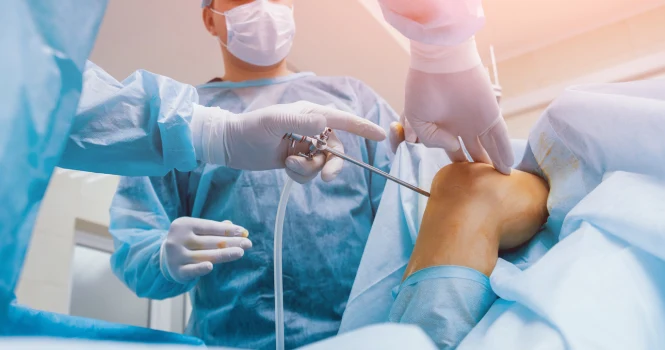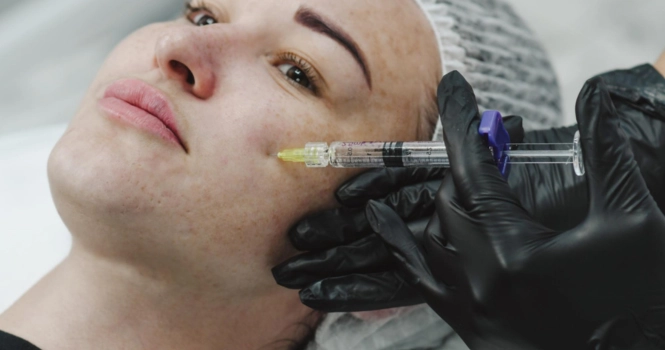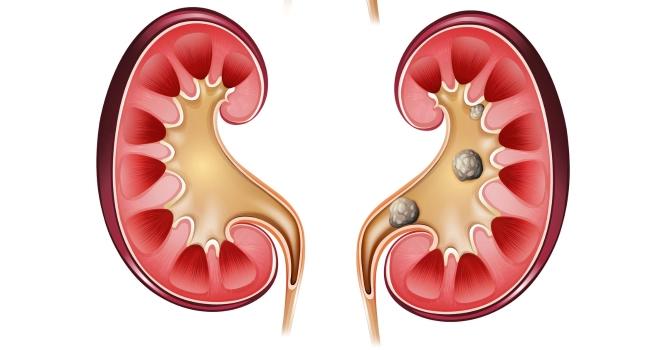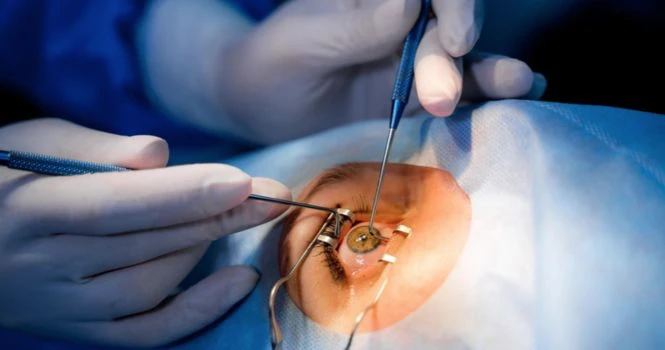Total Knee replacement surgery, medically referred to as arthroplasty, stands as one of the most commonly performed orthopaedic procedures in the world today.
In a society where mobility is paramount and an aging population is more active than ever, the need for functional and pain-free joints has never been greater.
Knee replacement surgery offers a promising solution to those suffering from debilitating knee pain caused by arthritis, injury, or other underlying conditions.
But what exactly does this procedure involve?
Who is an ideal candidate, and what can one expect in terms of recovery?
In this comprehensive overview, we will delve into the intricacies of knee replacement surgery, from the decision-making process to the operation itself, exploring the various types and techniques, and your road to recovery.
Function of the Knee Joint
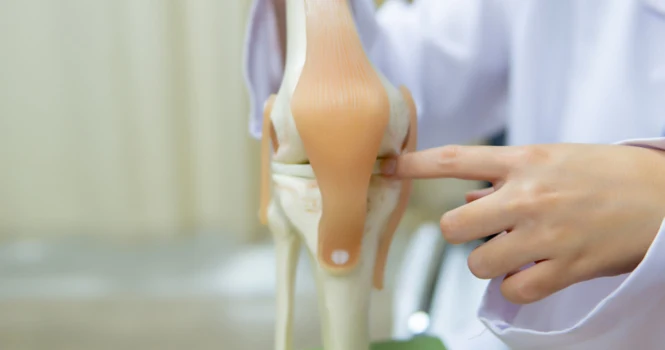
The knee joint serves several critical functions that facilitate everyday movements and activities. Here are the primary functions of the knee joint:
1. Movement and Mobility: The knee joint is a hinge joint that allows for flexion (bending) and extension (straightening) of the leg. This basic functionality enables a wide range of movements, from walking and running to jumping, squatting, and kicking.
2. Weight-Bearing: As one of the largest and strongest joints in the body, the knee plays a crucial role in supporting the body’s weight, particularly during weight-bearing activities. This function is especially evident when we stand, walk, or carry heavy objects.
3. Shock Absorption: The knee, especially the cartilage and menisci within the joint, helps absorb shocks and reduces impact forces transmitted from the ground during activities like walking, running, or jumping. This function is essential in preventing damage to the bones and other structures in and around the joint.
4. Stability: The ligaments within the knee joint – the anterior and posterior cruciate ligaments and the medial and lateral collateral ligaments – work together to provide stability to the knee. They limit the joint’s range of motion to prevent excessive movement that could lead to injury.
5. Rotation: Although primarily a hinge joint, the knee also allows a small degree of rotational movement when it is bent. This rotation provides the flexibility necessary for complex movements and activities, like dancing or playing sports.
Understanding the complex functionality of the knee joint is essential for appreciating the profound impact that knee injuries and diseases can have on a person’s mobility and quality of life. It also underscores the importance of procedures like knee replacements in restoring normal knee function.
Common Diseases and Injuries that can Affect the Knee
The knee is one of the most frequently injured joints due to its complex structure and the considerable forces it withstands. Several common diseases and injuries can affect the knee, leading to pain and limited function. Some of these include:
1. Osteoarthritis: This is a degenerative joint disease where the cartilage that cushions the knee joint wears away over time. It is commonly associated with aging but can also result from injury or overuse. Symptoms include pain, stiffness, and reduced mobility.
2. Rheumatoid Arthritis: This is an autoimmune disease in which the body’s immune system mistakenly attacks the lining of the knee joint, causing inflammation, pain, and swelling. Over time, rheumatoid arthritis can damage the cartilage and bones within the knee joint.
3. Meniscal Tears: The menisci are two pieces of cartilage in the knee that act as shock absorbers between the femur and tibia. These can tear from sudden twists, pivots, or due to age-related wear and tear. A torn meniscus can cause pain, swelling, and instability in the knee.
4. Anterior Cruciate Ligament (ACL) Injuries: The ACL is one of the key ligaments in the knee, and it can tear if you suddenly slow down and change direction, pivot, or land from a jump. This injury is common in sports like soccer, basketball, and skiing. Symptoms often include a “popping” sensation in the knee, severe pain, and swelling.
5. Patellofemoral Syndrome: Also known as “runner’s knee,” this condition is common in athletes and results from stress on the knee joint from running, squatting, or jumping. It can cause pain around the kneecap and difficulty with prolonged sitting or climbing stairs.
6. Bursitis: This condition occurs when the bursae, small sacs of fluid that cushion the outside of the knee joint, become inflamed, often due to repetitive kneeling or impact. Bursitis can cause pain and swelling around the knee joint.
7. Tendinitis: Also known as “jumper’s knee,” tendinitis is an inflammation of the tendons, often caused by repetitive stress from activities like running or jumping. It can cause pain in the front of the knee, especially during activities.
These conditions can significantly impair a person’s mobility and quality of life, making regular activities and movements difficult or painful.
In many cases, if these conditions can’t be effectively managed with conservative treatments like physical therapy, medications, or lifestyle changes, a knee replacement may be considered to alleviate pain and improve function.
What is Knee Replacement Surgery?
Definition of Knee Replacement
Knee replacement, also known as knee arthroplasty, is a surgical procedure that involves replacing the worn-out or damaged surfaces of the knee joint with artificial parts (prostheses) made of metal and plastic.
The goal of the surgery is to alleviate pain and restore function in severely diseased knee joints, often resulting from conditions like osteoarthritis, rheumatoid arthritis, or trauma.
There are two main types of knee replacement surgery:
1. Total Knee Replacement (TKR):
This involves replacing all three components of the knee joint – the femoral component (lower end of the femur), the tibial component (upper end of the tibia), and the patellar component (back of the patella).
2. Partial Knee Replacement (PKR):
Also known as unicompartmental knee replacement, this procedure involves replacing only the damaged portion of the knee, leaving the healthy parts intact. It’s less invasive than a total knee replacement and usually allows for a quicker recovery.
1. Total Knee Replacement
Total Knee Replacement, also known as total knee arthroplasty, is a surgical procedure that involves replacing damaged, worn, or diseased parts of the knee joint with artificial components.
This operation is typically recommended for individuals suffering from severe arthritis or knee injuries that have not responded to conservative treatments like medication, physical therapy, or less invasive surgical procedures.
During the surgery, the damaged cartilage and bone from the surface of the knee joint are removed and replaced with a prosthetic joint made of metal and plastic. The objective is to alleviate pain and restore mobility and function to the knee, thereby improving the individual’s quality of life.
The procedure is highly effective for pain relief and restoration of knee function, with success rates often exceeding 90%. Recovery generally involves an initial hospital stay, followed by several weeks of physical therapy to regain strength and range of motion.
Although total knee replacement is considered a safe and effective treatment for end-stage knee osteoarthritis and other degenerative conditions, it is a major surgical intervention that comes with its own set of risks and complications.
Potential issues can include infection, blood clots, nerve or blood vessel damage, and complications related to anesthesia. In some cases, the artificial joint may also wear out or fail over time, requiring revision surgery.
Therefore, the decision to undergo a total knee replacement should be made carefully, taking into consideration factors like the patient’s overall health, the severity of the knee condition, and the patient’s ability to participate in post-surgical rehabilitation.
Advances in surgical techniques and prosthetic materials continue to evolve, aiming to minimize these risks and improve the longevity of the artificial joint.
Overall, total knee replacement remains a highly beneficial option for those with severe knee conditions, significantly improving the ability to perform everyday activities without pain or restriction.
2. Partial Knee Replacement
Partial Knee Replacement, also known as unicompartmental knee arthroplasty, is a surgical procedure designed to replace only the damaged or worn-out part of the knee joint, as opposed to replacing the entire joint as in a total knee replacement.
This surgery is typically considered for patients whose knee damage is limited to a specific compartment of the knee, commonly either the medial (inner) or lateral (outer) compartment.
During the procedure, the surgeon removes the damaged cartilage and bone tissue and replaces it with a prosthetic implant made from materials like metal and plastic. The goal of a partial knee replacement is to relieve pain and improve function while preserving as much of the patient’s own tissue and bone structure as possible.
Because this approach is less invasive than a total knee replacement, patients often experience shorter recovery times, less post-operative pain, and a more “natural” feeling in the knee after surgery.
While partial knee replacement has its advantages, it’s not suitable for everyone. It’s generally recommended for patients who are older, less active, and whose knee damage is confined to a single compartment.
It’s not typically advised for those with severe or advanced osteoarthritis affecting multiple areas of the knee, or for those with certain kinds of knee instability or ligament damage. Just like total knee replacement, the surgery carries risks such as infection, blood clots, and complications related to anesthesia.
There’s also a chance that arthritis could develop in the parts of the knee that weren’t replaced, potentially requiring a total knee replacement later on. Despite these considerations, for the appropriate candidates, partial knee replacement can provide significant relief from pain and a quicker return to normal activities.
3. Knee Revision Surgery
Knee Revision Surgery is a procedure that involves removing and replacing a previously implanted artificial knee joint, or prosthesis.
This type of surgery is generally more complex than the initial total or partial knee replacement and is undertaken when the artificial joint has failed due to various reasons such as wear and tear, infection, or mechanical failure.
Unlike the first surgery, the revision process often involves the removal of additional bone and tissue to accommodate the new prosthesis, making it a more complicated and lengthy operation.
The primary objectives are to relieve pain, restore function, and correct any deformities that may have occurred as a result of the failed prosthesis.
Surgeons often employ specialized tools and surgical techniques for this kind of operation, and the prostheses used may also be different from those used in initial replacement surgeries, designed specifically for revision cases.
The expected outcomes can vary significantly depending on the reason for the revision and the condition of the surrounding tissues and bone.
Given the complexity of knee revision surgery, the associated risks are often higher than those of the initial replacement procedure. Patients may face a greater likelihood of complications, such as infection, bleeding, blood clots, and issues related to anesthesia. The recovery period is also generally longer and may require an extended stay in the hospital followed by intensive physical therapy.
Despite these challenges, knee revision surgery is often the best option for patients experiencing issues with a previous knee replacement. The long-term success rates for knee revision surgeries are generally good but tend to be slightly lower than those for primary knee replacements.
Therefore, the decision to undergo a revision should be carefully weighed against the potential benefits and risks, taking into consideration factors like the patient’s overall health, the expertise of the surgical team, and the specific reasons necessitating the revision.
Reasons to Undergo Total Knee Replacement
A. Explanation of Medical Conditions that May Lead to the Procedure
1. Osteoarthritis: This is a common form of arthritis that involves the gradual breakdown and eventual loss of the cartilage within the knee joint.
Cartilage is a tough, flexible connective tissue that protects the ends of bones and allows smooth joint movement. When cartilage wears away, bone rubs against bone, leading to joint damage and pain.
Osteoarthritis of the knee can cause severe pain, stiffness, swelling, and reduced mobility, which can significantly affect a person’s quality of life. It often affects middle-aged and older people but can also occur in younger people due to injury or overuse.
In early stages, osteoarthritis is usually managed with conservative treatments like physical therapy, lifestyle modifications, and medications for pain relief. However, as the disease progresses and symptoms worsen, these treatments may no longer be effective. At this point, a knee replacement may be considered.
Knee replacement surgery can provide significant pain relief for people with osteoarthritis and help them return to their regular activities. By replacing the damaged knee joint with an artificial one, the surgery can alleviate pain and improve function, allowing individuals to lead more active and fulfilling lives.
This is a common reason for knee replacement surgery, and many patients experience significant improvements in their symptoms and quality of life after the procedure.
However, the decision to undergo surgery is a personal one and should be made in consultation with the Orthopaedic Surgeon, taking into account the patient’s specific situation, overall health, and personal preferences.
2. Rheumatoid Arthritis: Rheumatoid arthritis (RA) is a chronic autoimmune disorder that primarily affects joints, causing inflammation, pain, and swelling.
Unlike osteoarthritis, which typically affects older people and results from wear and tear, RA can affect people of all ages and involves the immune system attacking healthy joint tissue.
In the knee, RA can damage the lining of the joint (synovium), leading to severe pain, stiffness, and swelling. Over time, the inflammation can damage the cartilage and bone within the joint, leading to changes in the shape and alignment of the knee and reduced function.
Like osteoarthritis, conservative treatments are usually the first line of defense against rheumatoid arthritis.
These may include medications to reduce inflammation and slow the progression of the disease, physical therapy, lifestyle modifications, and occasionally, injections into the knee joint.
However, if these treatments are not effective, or if the joint damage is severe, knee replacement surgery may be considered.
Knee replacement can alleviate pain, correct deformities, and restore function in people with rheumatoid arthritis. In this surgery, the damaged joint is removed and replaced with an artificial one, allowing for smoother and less painful movement.
As with any major surgery, the decision to have a knee replacement should be made in consultation with a Orthopaedic Surgeon, taking into account the severity of the disease, the patient’s overall health, and their personal preferences and lifestyle.
3. Trauma or Injury: Serious injuries to the knee can sometimes necessitate a knee replacement procedure. Trauma such as a car accident, sports injury, or a bad fall can cause significant damage to the bones, ligaments, tendons, and cartilage in the knee joint, leading to acute pain and reduced mobility.
Common types of traumatic injuries that can lead to a knee replacement include fractures of the knee joint, severe dislocations, or complex ligament tears that do not respond to conservative treatment.
When a traumatic injury results in severe damage to the knee that can’t be effectively treated with less invasive options, a knee replacement may be necessary.
These types of injuries often involve multiple structures in the knee and may lead to a misaligned or unstable joint if not properly treated.
In a knee replacement surgery following trauma, the damaged parts of the knee joint are removed and replaced with artificial components. This can help restore normal knee function, alleviate pain, and improve the patient’s quality of life.
As always, the decision to undergo knee replacement surgery should be made after discussing all treatment options with a healthcare provider, considering factors like the extent of the injury, the patient’s overall health, and their personal preferences and goals for recovery.
B. Description of Symptoms that May Warrant a Knee Replacement
1. Severe Knee Pain: This is the most common symptom that might necessitate a knee replacement. The pain is usually a chronic, dull ache that occurs with activity and may even interfere with sleep. Over time, as the underlying condition worsens, the pain might be present even at rest.
2. Joint Stiffness: Stiffness in the knee joint can make it difficult to bend or straighten the knee, impacting everyday activities such as walking, climbing stairs, or getting in and out of chairs or cars.
3. Decreased Mobility: Reduced mobility, particularly difficulty walking or moving the joint, can be a reason for knee replacement. This might manifest as a limp, or the need to use a cane or other walking aid.
4. Instability or Weakness: If the knee joint feels unstable, as if it might give out, or if it actually buckles or collapses under the person’s weight, a knee replacement might be warranted.
5. Swelling: Chronic swelling that doesn’t improve with rest or medications can be a sign that the damage to the knee joint is severe enough to consider surgery.
6. Failed Conservative Treatment: If symptoms persist despite non-surgical treatments such as medication, physical therapy, lifestyle changes, or injections, it might be time to consider a knee replacement.
7. Significant Impact on Quality of Life: Perhaps the most important consideration is the impact of knee problems on the person’s quality of life. If knee pain or dysfunction significantly impairs the person’s ability to engage in daily activities, hobbies, work, or if it causes ongoing distress, a knee replacement may be a worthwhile option to improve the individual’s quality of life.
C. Benefits and Potential Risks of the Procedure
1. Benefits of Knee Replacement Surgery:
A. Pain Relief: The primary benefit of knee replacement surgery is relief from severe, chronic knee pain.
B. Improved Mobility: Knee replacement can significantly improve mobility, allowing patients to return to daily activities and enjoy a better quality of life.
C. Improved Knee Function: By replacing damaged parts of the knee with artificial components, knee replacement can enhance the function of the knee joint.
D. Increased Independence: Improved mobility and reduced pain can increase a patient’s independence, especially in performing daily activities such as walking, climbing stairs, or getting out of a chair.
E. Improved Quality of Life: By reducing pain and improving mobility, knee replacement surgery can overall enhance a person’s quality of life, allowing them to engage more fully in work, social activities, and hobbies.
2. Potential Risks and Complications of Knee Replacement Surgery:
A. Infection: As with any surgery, there’s a risk of infection. This can occur in the skin, around the artificial joint, or in other parts of the body.
B. Blood Clots: Surgery increases the risk of blood clots in the legs, which can travel to the lungs (pulmonary embolism) – a serious condition.
C. Implant Problems: The artificial knee joint can become loose, dislocate, wear out, or fail for other reasons, which may require additional surgery.
D. Continued Pain: Some patients may continue to experience knee pain after surgery.
E. Stiffness: In some cases, the knee may become stiff after surgery due to scarring or other issues.
F. Nerve and Blood Vessel Damage: Although rare, during surgery, nerves and blood vessels around the knee can be injured.
It’s important to note that while knee replacement surgery has potential risks, the procedure has been performed for many years with good results.
Most people experience a significant reduction in pain and improvement in function. Risk is minimized by using experienced surgeons and facilities, carefully following pre- and post-surgery instructions, and maintaining a healthy lifestyle both before and after surgery.
The Knee Replacement Procedure
A. Preoperative Preparation
1. Medical Evaluations:
- Physical Examination: This includes a thorough assessment of the knee joint, as well as an overall health check to ensure the patient is healthy enough for surgery.
- Imaging Tests: These may include X-rays, CT scans, or MRI to provide a detailed image of the knee joint and surrounding structures.
- Lab Tests: Blood tests and other laboratory tests may be conducted to assess the patient’s general health and readiness for surgery.
2. Physiotherapy:
- Preoperative Exercises: Physiotherapy is often prescribed to strengthen the muscles around the knee and improve flexibility before surgery. This can help speed up recovery post-surgery.
- Education about Postoperative Physiotherapy: The physiotherapist may also explain and demonstrate exercises that will be part of the postoperative recovery regimen, so the patient is familiar with them before the surgery.
3. Lifestyle Modifications:
- Weight Loss: If the patient is overweight, losing weight can reduce stress on the new joint and lower the risk of complications.
- Smoking Cessation: If the patient smokes, stopping before surgery can reduce the risk of wound healing complications and improve recovery.
- Medication Review: The surgeon or anesthesiologist will review the patient’s medications and advise on which ones should be stopped before surgery.
- Home Preparation: The patient may need to make modifications at home to facilitate recovery, such as arranging for help, setting up a bed on the main floor if stairs are an issue, or installing safety bars in the bathroom.
B. Description of the Surgical Procedure Step-by-Step
1. Anesthesia:
- Before the surgery begins, the patient will be administered either general anesthesia, which puts you to sleep for the duration of the surgery, or regional anesthesia, which numbs you below the waist, while you remain conscious.
The choice depends on your overall health, the length of the procedure, and your personal preference. An anesthesiologist will be present throughout the surgery to monitor your vital signs and manage your anesthesia.
2. Incision and Removal of Damaged Knee Joint:
- The surgeon will start the procedure by making an incision in the front of the knee to expose the joint. The incision is typically about 6 to 10 inches long, depending on the patient’s size and the surgeon’s preference.
- The damaged joint surfaces and underlying bone are carefully removed. This involves cutting the ends of the femur (thighbone), tibia (shinbone), and often the underside of the patella (kneecap) to prepare for the new artificial joint.
3. Implantation of the Prosthetic Joint:
- The removed bone and cartilage are replaced with metal components that recreate the surface of the joint. These metal parts may be cemented into place or “press-fit” into the bone, allowing the bone to grow into the implant over time.
- A spacer made of medical-grade plastic is inserted between the metal components to create a smooth gliding surface. This is what your new joint will use to bend and move.
4. Closing the Incision:
- Once the artificial components are securely in place and the joint’s function has been tested, the surgeon closes the incision with sutures (stitches) or staples.
- A sterile bandage is then applied to protect the wound and minimize the risk of infection.
This is a basic step-by-step overview of a knee replacement procedure. However, the exact process may vary depending on the specific techniques used by the surgeon, the type of prosthetic joint used, and the patient’s individual anatomy and health condition.
It’s important to have a discussion with the surgeon to understand the specific details of the planned procedure.
C. Postoperative Care
1. Recovery Room and Hospital Stay:
- After surgery, you’ll be taken to the recovery room where staff will monitor you as the anesthesia wears off. Here, your pain levels, vital signs, and knee function will be closely watched.
- Once stable, you’ll be moved to your hospital room. The length of the hospital stay varies, but typically, it’s between 2 to 4 days. The duration depends on your overall health and how quickly you progress with physical therapy.
2. Pain Management:
- It’s normal to experience some pain after surgery. Your medical team will administer pain relievers to keep you comfortable. These may include opioids, non-steroidal anti-inflammatory drugs (NSAIDs), and local anesthetics.
- Your doctor might also use regional nerve blocks or epidural analgesia, where medication is delivered directly around the nerves in your spine or joint, numbing a larger area.
3. Physiotherapy and Rehabilitation:
- Early mobilization is crucial for a successful recovery. You’ll begin physical therapy often on the day of surgery or the day after. The physiotherapist will guide you through exercises to strengthen your knee and improve flexibility.
- A continuous passive motion (CPM) machine might be used to move your knee joint slowly while you are in bed. This machine can help reduce stiffness and swelling.
- You’ll also learn how to safely perform daily activities, like getting in and out of bed, using the bathroom, and navigating stairs.
4. Monitoring for Complications:
- Staff will regularly check your wound for signs of infection, such as increased pain, redness, swelling, or draining.
- They’ll also monitor for potential complications like blood clots. Measures to prevent blood clots include blood-thinning medications, compression devices, and encouraging movement as soon as possible.
- Once discharged, it’s important to follow up with your surgeon. Follow-up visits allow your surgeon to assess your progress, address any concerns, and catch potential complications early. Typically, the first follow-up visit is scheduled for 2-6 weeks after discharge.
Living with a Knee Replacement
A. What to Expect After Knee Replacement Surgery
1. Short-Term Changes:
- Rehabilitation: You’ll likely need regular physiotherapy for several weeks to months after surgery. This helps strengthen the knee and improve flexibility.
- Temporary Mobility Assistance: Initially, you’ll need to use crutches, a walker, or a cane to help you move around. As your strength and mobility improve, you’ll gradually reduce your reliance on these aids.
- Activity Modifications: You’ll need to avoid certain high-impact activities for a few months to allow the knee to heal properly. These might include jogging, jumping, or any other activities that put significant stress on the joint.
- Wound Care: You’ll need to clean and care for your surgical wound as directed by your healthcare provider to prevent infection.
2. Long-Term Changes:
- Regular Physical Activity: Regular low-impact physical activity is crucial for maintaining strength and flexibility in the new knee. Walking, swimming, and cycling are good choices.
- Periodic Follow-up Visits: Regular check-ups with your surgeon are important to monitor the status of your artificial knee joint.
- Continued Pain Management: Although most people experience significant pain relief after knee replacement, some may still experience occasional discomfort. Over-the-counter pain relievers can typically manage this.
- Activity Modifications: Even after you’ve fully recovered, you’ll need to avoid certain high-impact activities that could damage your new knee joint. These might include high-impact sports like football or basketball, heavy lifting, or repetitive heavy labor.
Remember that each person’s recovery process is unique, and it’s important to discuss your individual recovery timeline and activity modifications with your surgeon or physical therapist.
They can provide you with the most accurate and personalized advice based on your overall health and specific surgical outcome.
B. How to Maximize the Life of a Knee Replacement
1. Regular Exercises:
- Regular low-impact exercise can help to maintain muscle strength, joint flexibility, and general fitness, all of which contribute to the long-term success of your knee replacement. Activities such as walking, swimming, cycling, and non-weight bearing gym exercises are excellent choices.
- You should also continue with any specific exercises recommended by your physiotherapist, even after your formal physiotherapy sessions have ended. These exercises are designed to improve the strength and flexibility of your knee and can contribute significantly to the lifespan of your replacement.
2. Weight Management:
- Maintaining a healthy weight is crucial for maximizing the life of your knee replacement. Excess body weight can place additional stress on your knee joint and can lead to wear and tear of the prosthesis more quickly.
- If you’re overweight, speak to your doctor or a dietitian about strategies to lose weight in a healthy and sustainable manner. This might involve changes to your diet, regular physical activity, or a combination of both.
3. Regular Check-ups:
- Regular follow-up appointments with your orthopedic surgeon are an important part of taking care of your knee replacement. These appointments allow your surgeon to monitor the condition of your replacement and identify any potential issues early, before they become major problems.
- In addition to regular check-ups, you should contact your doctor if you notice any changes in the way your knee feels or functions. Pain, swelling, instability, or decreased function can all be signs of a problem and should be evaluated by your doctor promptly.
Remember, a knee replacement is a major operation and it can take time for you to return to your normal activities.
It’s important to be patient with your body and allow it the time it needs to heal. With proper care and attention, a knee replacement can provide pain relief and improved mobility for many years.
If you are looking to consult with Knee Replacement Surgeon in India, then contact us on info@irastoworldhealth.com
